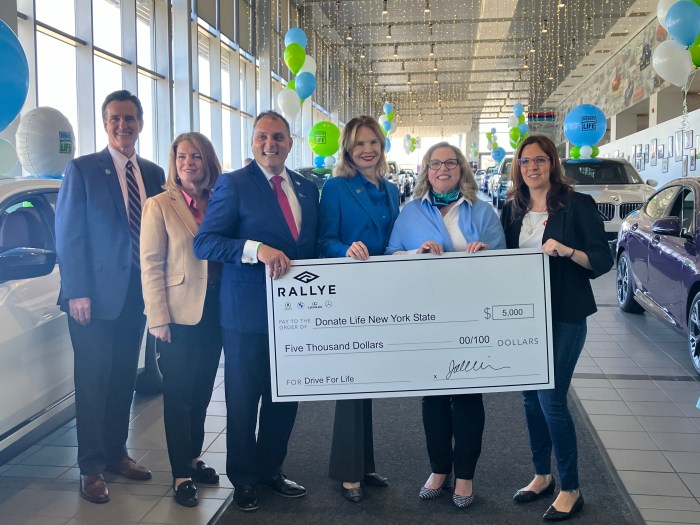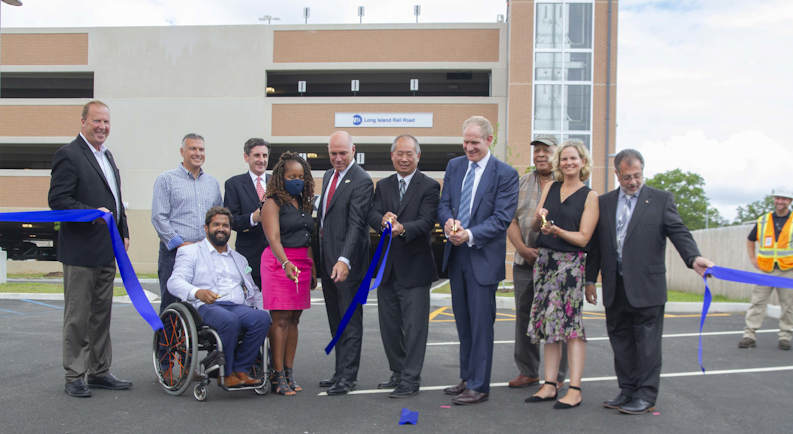
MTA, LIRR chiefs on hand for ribbon cutting
The Westbury railroad station parking garage was conceived at a time when ridership on the Long Island Rail Road was steadily rising and parking spaces at railroad stations were at a premium.
The COVID-19 pandemic changed all that. Many daily commuters have not returned to shuttered NYC offices. The shutdown of the city’s rich cultural world depressed the ridership as well.
According to Westbury Mayor Peter Cavallaro, the number of annual commuter parking tickets sold to Westbury residents is about half of what it was pre-pandemic. The facility has room for 683 cars, and 376 spaces are reserved for Westbury residents. The others are going to be daily metered spots available to the public. Surrounding the garage are an additional 107 resident-only surface spots.
All this was on the mind of MTA Acting Chairman and CEO Janno Lieber and Long Island Rail Road President Phil Eng when they came to the village on Aug. 9 to cut the ribbon for the new facility. As the transportation leaders spoke, a digital display above the garage door indicated that 536 spaces were available.
“Are you still confident that all of these spaces will be needed?” Lieber was asked.
He replied, “Nobody has a crystal ball on how quickly ridership is going to come back, but the projections that we have made show that the commuter railroad ridership is going to take a couple of years, but it is going to come back. And what the Third Track project is delivering is the ability to do much more. [We have] the incredible safety benefits of eliminating all those grade crossings and having the capacity to run true reverse commuting for the first time in anybody’s memory—these are truly huge benefits.”
He added, “We would not be depending on the exact pace of ridership returning to justify this project. There are so many other reasons, but we’re also confident with the dynamic Long Island economy that we’re seeing that ridership is going to come back and we need to be ready and this project makes that certain.”
Eng told Anton Media Group that monthly commutation sales had been flat even before the pandemic, but ridership had set records in the months before the pandemic. He believed destination travel would be the railroad’s future even as NYC slowly recovers and its office workers and professionals would be returning to their daily commutes.
Celebrating Partnership
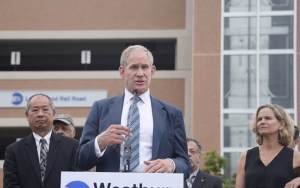
Nassau County Executive Laura Curran was also on hand, and joined Lieber and Eng in celebrating the partnership among agencies, contractors and municipalities that helped to move the Long Island Expansion Project forward.
Lieber praised Mayor Cavallaro, “who has really been a visionary behind all this project and an incredible partner.” He also mentioned another partner, Westbury Building Inspector William Mello.
Curran repeated Lieber’s observation that the project was done on-time and on-budget, thanks mainly to the efforts of the workforce.
“I think that cannot be stressed enough in the age of COVID,” she said. “[We live] in a complicated world right now. The fact that this is getting done—honestly, this is what a successful partnership looks like. The MTA working with [labor leader] Anthony Simon and his team, working with the Village of Westbury and let’s not forget we are in the Town of North Hempstead—there are many layers of municipalities that need to work together.”
Trustees Steve Corte and William Wise represented Mayor Cavallaro, who had a scheduling conflict. Town Clerk Wayne Wink represented North Hempstead, along with Councilwoman Viviana Russell of the New Cassel section of Westbury.
“This train station is really important,” Curran continued. “It will encourage density where it makes sense. It will draw more people here. It will keep more people here in our beautiful communities of Nassau County. It is exactly what we need at exactly the right time.”
Lieber noted that the numerous capital projects under his purview are on-time and on-budget despite COVID-19.
“The Third Track project continues to be a model of how the MTA can deliver its entire program faster and less expensively through the use of design built. And Westbury commuters have a lot to look forward to,” he said, naming various improvements to the station.
The garage was built on a parking lot owned by the village. The MTA owns the parking lot south of the station and has sent out a request for proposals focused on what Lieber called transit-oriented development.
“This is something that many of us, led by the county executive, have been talking about for some time,” he affirmed. “We want to take advantage of areas that we have an opportunity to do a little bit of multi-family development close to train stations and close to transportation facilities in general to create more dynamic village downtowns, more walkable areas, and also a sustainable model of development.”
Lieber concluded, “We need to keep working to modernize mass transit. The MTA is the key to rebuilding the regional economy. New York does not happen without the MTA and we’re going to be ready to support Long Island’s recovery.”
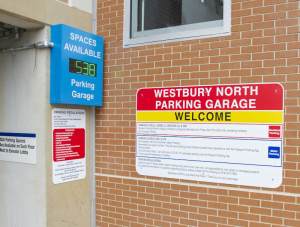
MTA Chief Accessibility Officer Quemuel Arroyo stated, “The accessibility features at this station are a major plus for everyone—enhanced lighting, 21 accessible parking spots and a fully accessible garage with two elevators. I am so proud of the way that the MTA is modernizing to create a more inclusive system that leaves no one behind and I am glad to see such a robust level of community engagement in these projects.”
Eng also praised the team effort to bring the garage to completion, as well as the other finished components of the expansion project.
“I recall back in 2016, during the initial outreach, [Mayor Cavallaro’s] open dialogue with us in regards to this project and the needs of the community,” the LIRR chief said. “Because of this open dialogue between all of these important stakeholders we’re working together we’ve been able to accomplish big things for the Long Island Railroad customers here and at all the other communities that we serve. We’re thrilled to have this parking garage as part of our transportation network solution.”
Lieber observed, “All of all of these elements of the projects and the improvements in Westbury were based on community feedback and this project has excelled in how it deals with the community. Building this amazing complex project amidst the most developed parts of Long Island…creates community challenges and we’ve stayed close to the communities throughout to make sure people understood the benefits and that we were working with them to minimize the inconveniences.”
Anthony Simon, general chairman of the International Association of Sheet Metal, Air, Rail and Transportation Workers, who negotiated the last contract for 5,400 LIRR workers, praised the transportation leaders and the workforce.
“You cannot do this without labor. You cannot do it without the workforce,” he said. “There’s a lot of people involved so we can continue working collaboratively with labor and with management to get the job done. During the toughest times that we faced during COVID, we kept coming out, we kept building, we kept making it better. But it was all for the commuters.”
He added, “It’s very important to understand that the MTA lost a lot of good people during COVID, but we never stopped,” mentioning 168 deaths attributable to the virus.
Simon continued, “We could not have done that without the support of our great County Executive Laura Curran, who has been on the ground every day, asking questions, trying to get these projects done. She is a true example of a leader for Nassau County and a good friend of labor.”
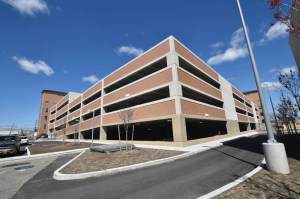
Eng asserted that the MTA is building for future generations, and hoped that municipalities would “continue to see the great benefits and vibrancy of the local downtowns that have embraced transit-oriented development. The kind of downtowns that I can envision my children wanting to live, and spend time in in the future.”
He concluded, “We’ve done not just big things, but meaningful things with more to come.”
Station Improvements
Renovations at the Westbury LIRR station, located across the street from the parking garage, are expected to be completed in the fall of 2022. These additional station improvements include:
• Platform replacement to accommodate a new third track
• Platform canopies and station building renovation
• New furnishings including benches, shelters, and wayfinding
• CCTV security cameras to improve safety
• Extension of pedestrian tunnel and ADA ramps and elevators
• Free public wi-fi
• USB charging stations and digital information displays
• Bike racks and artwork
• Pocket park near Post Avenue
Quotables
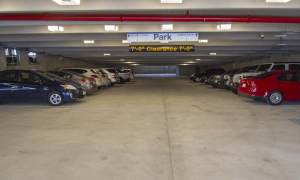
Additional comments made by the principals, from the MTA’s official press release:
“This project continues to be a model for how the MTA is delivering infrastructure projects better, faster and cheaper,” Lieber said. “Despite the challenges faced during the COVID pandemic, the Third Track project remains on schedule and on budget.”
“LIRR stations are the cornerstone to successful transit-oriented downtowns,” Eng said. “The ongoing work at Westbury Station, including this new parking facility, demonstrates our commitment to the future of Long Island. We’re grateful for the community participation and feedback that was instrumental and helped us meet the needs of the public.”
“Riders along the main line are coming back to a more accessible and inclusive Long Island Rail Road with more options for on-site parking in our stations,” said MTA Chief Accessibility Officer Quemuel Arroyo. “In the short time that I have been here, the MTA continues to make accessibility a priority across all agencies.”
“Making improvements to our public transportation are a key part of getting our County back to normal,” said Curran. “The availability of new parking spots at the Westbury LIRR station is an important component of the LIRR expansion project and will make a tremendous difference for many residents who rely on the train. Thank you to the MTA for keeping this project on track despite difficulties brought on by the pandemic.”
“This is yet another example of how successful MTA/LIRR can be by working together with labor to accomplish another great project. This success is for our riders who patiently wait for these projects to be completed,” said Simon. “It was especially difficult over the last year and half due to COVID but once again we delivered for our commuters and they deserve it. We look forward to seeing a robust return to our system. Thank you all for the dedication and hard work.”

“The village is excited and pleased that this important infrastructure improvement is coming to completion,” said Cavallaro. “The new garage will substantially increase the parking capacity at the Westbury train station for village residents and non-resident commuters and provide additional substantial off-hours parking for our downtown business district. Many downtowns and train stations struggle with inadequate parking, and this new facility will provide the parking resources that we need now and for years to come.”
“The completion of the parking garage will allow my constituents a smoother commuter experience,” said Assemblymember Charles Lavine. “Especially with free parking on weekends, it will allow the Village of Westbury to attract more New Yorkers and greatly contribute to its economic growth during a critical time as we continue to rise from the pandemic.”
“The construction of the new parking garage provides much needed parking accessibility to the residents of New Cassel, Westbury, and the neighboring Carle Place Community,” said Russell.
For more information visit AModernLI.com.
The Village Angle
According to Mayor Cavallaro, non-village residents can also make sue of metered parking on Railroad Avenue. The Westbury railroad station construction is ongoing, and for the duration, there will be no street parking on Union Avenue. In addition, only one way traffic is allowed westbound on Union Avenue from Linden Avenue to Post Avenue.
Effective Aug. 9, there will be no commuter parking on the south side of the station at the former lot. It will be used for construction staging. The MTA has put out a request for proposals for this property, which it owns. Under the new village zoning spurred by the $10 million Downtown Revitalization Initiative (DRI) state grant the village received in 2016, multi-unit housing may be erected on the site.
The MTA built the garage on property owned by the village and started a 40-year lease with the village on Oct. 9.
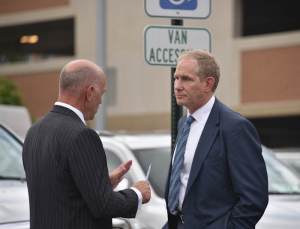
According to Cavallaro, “The MTA has two 10-year extensions that they could exercise if they want. So, the initial term would end Aug. 8, 2061, with the option of the MTA to extend to 2071 or 2081. The MTA owns the garage until the end of lease then it is turned over to village.”
Village Building Inspector William Mello stated at a recent village board meeting, “It’s great, it’s something we’ve been looking forward to for a long time. It’s going to basically double our capacity when the Long Island Railroad gets back to full swing.”
Cavallaro said that he’s heard that citizens of surrounding communities—Salisbury, New Cassel and Carle Place—have asked if they are eligible for yearly parking permits at the Westbury garage, which represent a sizable savings from daily passes. However, he reiterated that only village residents will be allowed to buy the yearly passes, which cost $65 and are available by calling the village clerk’s office at 516-334-1700.
According to the press release, daily parking rates “start at $6 for up to 20 hours on weekdays, and parking is free on weekends and holidays. The garage is open 24 hours a day, seven days a week and operated by Allpro Parking.”
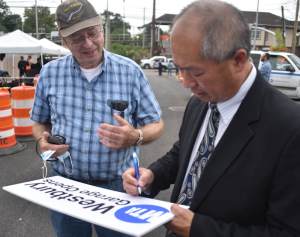
Cavallaro observed, “The village has engaged an outside engineering form to make sure that the garage was designed and constructed properly, including the development of a post-completion punch list of items that had to be addressed by 3TC.”
The importance of such oversight was made clear in 2017 when a commuter parking garage adjacent to the Hicksville railroad station developed cracks in the floor slab and it needed extensive and expensive renovation.
By The Numbers
The pandemic-induced economic shutdown put a dent on LIRR ridership. Though it has bounced back from last spring’s troughs, daily commuting to a city where many businesses have not allowed workers back is still down considerably from pre-pandemic numbers.
The LIRR, at the July meeting of the MTA board, released year-to-year ridership figures. Total ridership in June 2021 increased 179.2 percent compared to June 2020, However, when compared to June 2019, total ridership decreased by 59.8 percent. Daily commuting is slowly recovering, rising 141.3 percent compared to June 2020. However, year-to-date commutation ridership is 61.0 percent below 2020, reflecting the high pre-pandemic numbers.





